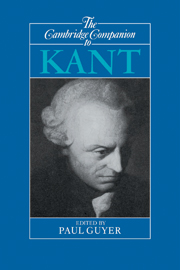Book contents
- Frontmatter
- Introduction
- 1 Kant's intellectual development
- 2 The Transcendental Aesthetic
- 3 Functions of thought and the synthesis of intuitions
- 4 The transcendental deduction of the categories
- 5 Causal laws and the foundations of natural science
- 6 Empirical, rational, and transcendental psychology
- 7 Reason and the practice of science
- 8 The critique of metaphysics
- 9 Vindicating reason
- 10 Autonomy, obligation, and virtue
- 11 Politics, freedom, and order
- 12 Taste, sublimity, and genius
- 13 Rational theology, moral faith, and religion
- 14 The first twenty years of critique
- Bibliography
- Index
14 - The first twenty years of critique
The Spinoza connection
Published online by Cambridge University Press: 28 May 2006
- Frontmatter
- Introduction
- 1 Kant's intellectual development
- 2 The Transcendental Aesthetic
- 3 Functions of thought and the synthesis of intuitions
- 4 The transcendental deduction of the categories
- 5 Causal laws and the foundations of natural science
- 6 Empirical, rational, and transcendental psychology
- 7 Reason and the practice of science
- 8 The critique of metaphysics
- 9 Vindicating reason
- 10 Autonomy, obligation, and virtue
- 11 Politics, freedom, and order
- 12 Taste, sublimity, and genius
- 13 Rational theology, moral faith, and religion
- 14 The first twenty years of critique
- Bibliography
- Index
Summary
Defining the limits of a historical period always entails an element of arbitrariness. There are good reasons, however, for setting the conclusion of the first cycle in the reception of Kant's critical program at August 7, 1799, just under twenty years after the first appearance of the Critique of Pure Reason. The date marks the publication of Kant's open letter in which he repudiated Fichte's Wissenschaftslehre and other attempts at bringing his transcendental philosophy to completion. His own critical work, which in the Critique he had claimed to be only of an introductory nature (A 11 / B 25), he now declared to constitute the system of pure reason itself. From that date onward the very reception of Kant became a problem, itself the subject of interpretation and reception. Moreover, at the end of the Critique of Pure Reason Kant had predicted that, following the path laid out by his program, one could “secure for human reason complete satisfaction” in regard to all its metaphysical preoccupations, and that this goal could be achieved “before the end of the present century” (A 856 / B 884).
- Type
- Chapter
- Information
- The Cambridge Companion to Kant , pp. 417 - 448Publisher: Cambridge University PressPrint publication year: 1992
- 5
- Cited by



